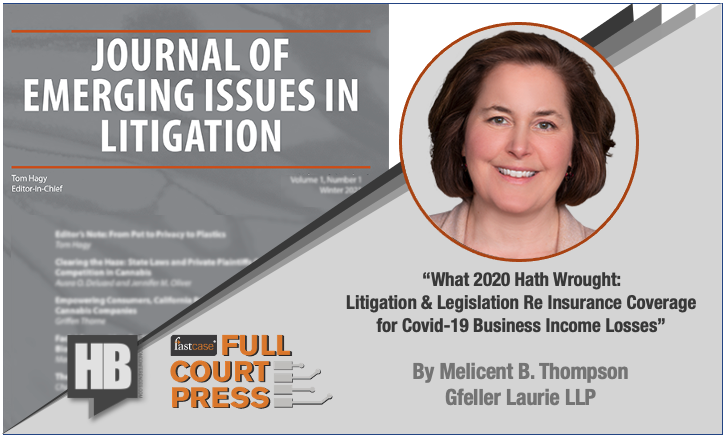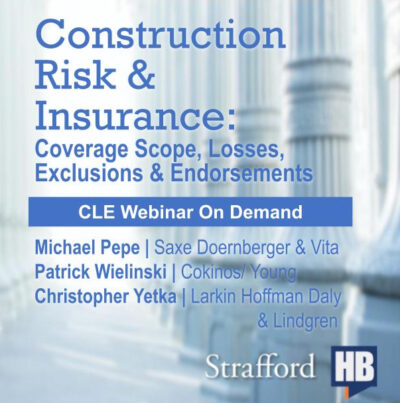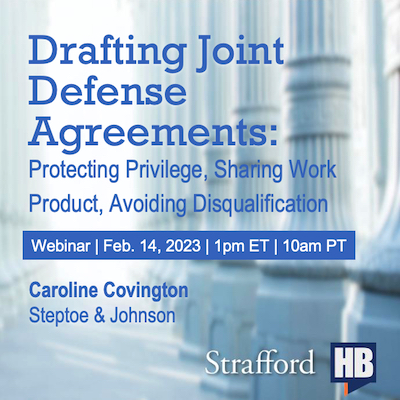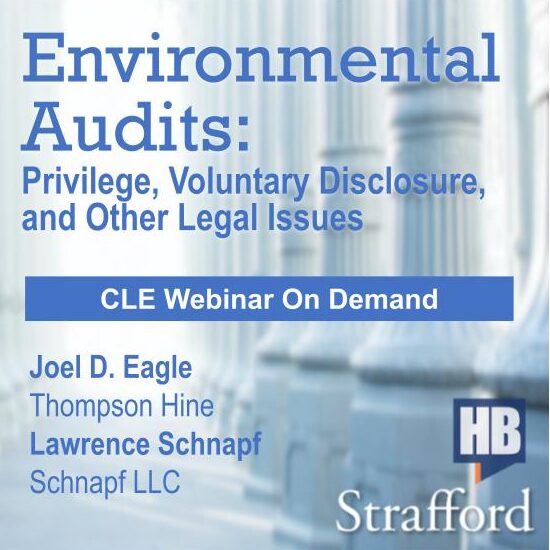Melicent B. Thompson on COVID-19 Coverage
Abstract
COVID-19 indisputably has taken an enormous economic toll. Governmental shutdown orders early in the pandemic and ongoing restrictions on business’ operations have resulted in a flood of claims for insurance coverage for business income losses attributable to those orders and restrictions. This article reviews the litigation and legislative developments directed at attempting to find insurance coverage for such losses and the reasons why those efforts have been unsuccessful for the most part.
Author
Melicent B. Thompson (mthompson@gllawgroup.com) is a Partner with the law firm Gfeller Laurie, LLP, in West Hartford, Connecticut. She thanks her fellow Gfeller Laurie, LLP attorneys who contributed to this article. Melicent has close to 25 years of experience in litigation and corporate counseling. She actively practices in Connecticut and Georgia courts in insurance coverage, business disputes, professional liability claims, defense of educational and financial institutions and general liability. Her insurance coverage practice encompasses all areas of first and third party claims and related litigation services, including declaratory judgment actions, defense of bad faith claims and reinsurance matters. Melicent has substantial appellate court experience, having briefed and argued appeals before the Second Circuit Court of Appeals and the Connecticut Supreme and Appellate Courts. Her pro bono work includes serving as General Counsel to the Board of Directors of Gifts of Love, a charity providing basic needs to the working poor, based in Avon, Connecticut. She also serves as a member of the Advisory Council of Bay Path University (Longmeadow, Massachusetts).
About
The Journal on Emerging Issues in Litigation is a co-production of HB, Fastcase, and Law Street Media. You can also hear the complementary (and complimentary) Emerging Litigation Podcast wherever podcasts appear. For questions, contact Tom Hagy, Editor in Chief, at Editor@LitigationConferences.com.
Construction Builders Risk and CGL Insurance: Scope of Coverage, Covered Losses, Exclusions, AI Endorsements
Construction Builders Risk and CGL Insurance: Scope of Coverage, Covered Losses, Exclusions, AI Endorsements: Mitigation Construction- Related Disputes; Key Challenges for Claims Under Builders Risk Vs CGL Coverage Counsel to builders and developers must consider are who is covered, what property is covered, what limits and sublimits apply, and when/how coverage applies. Because builders risk policies are not standardized, coverage varies dramatically between insurers. Coverage disputes often arise over the types of costs recoverable, calculation of economic damages, and the coverage exclusions and exceptions.For liability disputes, CGL coverage must be adequately placed to cover construction risks during the course of construction as well as after. Typical issues include who is covered, the scope of coverage, and exclusions and conditions that apply.Counsel often must also navigate the interplay between builders risk policies, CGL policies, including wrap policies, and professional liability policies. These issues are influenced by the language of the policies and the parties’ contractual obligations to each other. Attention to the details is necessary to ensure coverage is triggered when necessary.Listen as our authoritative panel guides you through the characteristics of builders risk and CGL insurance policies and how these policies are used to mitigate developer and contractor risks. Outline Builders risk policies Contractual requirements Scope of coverage Troublesome exclusions and conditions Common issues and practice pointers CGL policies Scope of coverage Exclusions and exceptions to exclusions Costs recoverable Wrap policies Additional insured endorsements A Strafford production specially selected for HB audiences. Michael V. Pepe Partner Saxe Doernberger & Vita Patrick Wielinski Principal Cokinos| Young Christopher Yetka Shareholder Larkin Hoffman Daly & Lindgren The panel will review these and other key issues: What are the critical challenges for claims under builders risk vs. CGL policies? What does a typical builders risk policy cover? What are the standard exclusions and exceptions in builders risk policies? What occurrences do most CGL policies cover? What are the standard exclusions and exceptions in CGL policies? Can a general contractor or developer rely upon additional insured coverage to [...]
Allocating CERCLA Liability: Divisibility or Section 113 Equitable Contribution
Allocating CERCLA Liability: Divisibility or Section 113 Equitable Contribution Assessing Harm, Proving Divisibility of Harm Defense Absent a Bright-Line Test, and Apportioning Costs The U.S. Supreme Court's decision in Burlington Northern & Santa Fe Railway Co. v. U.S. significantly changed the landscape for divisibility under CERCLA. However, there is no bright-line test for determining divisibility, and the courts have taken different approaches in evaluating this issue.In decisions involving the Fox River in Wisconsin and the Upper Columbia River in Washington state, as well as opinions from courts in Rhode Island and South Carolina, judges and parties have wrestled with the critical question for divisibility: is the harm "theoretically capable of apportionment"?If a court answers this question with a yes, the party seeking to limit its liability succeeds. If the answer is no, that party must try again under a much less favorable equitable allocation approach. These and other opinions addressing the divisibility/apportionment divide continue to guide courts, litigants, and pre-litigation parties as they attempt to settle or otherwise resolve responsibility at contaminated sites.Listen as our authoritative panel examines the statutory language and what the Burlington Northern decision and its progeny mean for divisibility. The panel will also review cases applying this problematic technical issue and offer practice pointers on which circumstances lend themselves to a divisibility defense and how to present it. Outline Divisibility defense under CERCLA Statutory language What the BNSF decision means for divisibility Section 113 equitable contribution Lessons learned from recent decisions Best practices Circumstances lending themselves to a divisibility defense Presenting a divisibility defense A Strafford production specially selected for HB audiences. Jane B. Story Partner Jones Day Rachel K. Roberts Attorney Beveridge & Diamond The panel will review these and other key issues: How are different jurisdictions applying the Burlington Northern decision in divisibility cases? What circumstances lend themselves to a divisibility defense? What steps can counsel take to overcome the challenging issues involved in proving divisibility?
Drafting Joint Defense Agreements: Protecting Privilege, Sharing Work Product, Avoiding Disqualification
Drafting Joint Defense Agreements: Protecting the Privilege, Sharing Work Product, Avoiding Disqualification Joint defense agreements can be a valuable tool for counsel representing co-defendants facing a variety of types of litigation, including intellectual property, securities, energy/environment, commercial litigation, antitrust, product liability, and mass torts. Joint defense agreements allow defendants to reduce costs and coordinate strategies, discovery, and filings.Joint defense agreements are not without risks, however.Sharing work product and confidential information among defendants--who are frequently also competitors--may expose and lead to future litigation among the co-defendants. Counsel considering entering into joint defense agreements must carefully scrutinize the pros and cons and establish preemptive safeguards to protect their client's interests and confidential information.Listen as our authoritative panel of experienced litigators examines the critical factors that parties contemplating a joiit defense argument must evaluate, the essential provisions of the deal itself, and strategies for meeting the legal ethics requirements related to joint defense agreements. Outline Considerations before entering a joint defense agreement Advantages and disadvantages Cost Participants What information to share Settlement issues Joint defense agreement Key provisions Provisions concerning disclosure Ethical considerations Conflicts of interest and potential disqualification Protecting privileged information Ethics opinions addressing joint defense A Strafford production specially selected for HB audiences. Caroline Covington Attorney Steptoe & Johnson The panel will review these and other key issues: What critical safeguards must defendants put in place to protect the joint defense privilege? What are the main steps that defendants working jointly can take to avoid or cope with potential conflicts? What preventative clauses should be incorporated into the joint defense agreement to minimize potential risks?
Environmental Audits: Privilege, Voluntary Disclosure, and Other Legal Issues
Environmental Audits: Privilege, Voluntary Disclosure and Other Legal Issues: Ensuring Compliance With Environmental Laws, Responding When Violations Are Discovered Environmental audits allow companies to proactively identify and address environmental problems before civil litigation or enforcement actions arise. The EPA and many states offer companies incentives to encourage compliance, including self-reporting identified issues in order to be eligible for potential reduced or eliminated penalties.Whether a newly acquired or long-standing business, companies and their counsel must take measures to ensure ongoing environmental compliance and environmental audits provide an avenue for detecting and correcting potential problems. Regular self-auditing can help reduce governmental penalties and limit injunctive relief faced in enforcement actions, apart from voluntary disclosure of noncompliance to regulatory agencies.There are potential risks associated with voluntarily uncovering and documenting violations, as well as with the disclosure of violations. Audit findings can be evidence of compliance gaps and a company's knowledge of those holes. And audit disclosures may not always lead to a clean resolution of disclosed violations with the regulatory agency. Disclosed information could still lead to enforcement action and also may provide ammunition in private actions against the disclosing party.Listen as our panel of environmental attorneys examines environmental enforcement policies and environmental auditing programs. The panel will discuss privilege and its exceptions, as well as the pros and cons of voluntary disclosures. The panel will also offer strategies for responding to enforcement actions. Outline Environmental compliance auditing Privileges available to protect audit-derived information Voluntary audit disclosure EPA program State programs Audit opportunities for new owners Complications for auditing and disclosure arising from recent enforcement trends A Strafford production specially selected for HB audiences. Joel D. Eagle Partner Thompson Hine Lawrence Schnapf Principal Schnapf LLC The panel will review these and other key issues: How can companies and their counsel use environmental audits to improve compliance and soften the impact of a government enforcement action? What are the best practices for counsel to advise clients that are considering utilizing environmental compliance audits? What are the expected costs and [...]
PFAS Consumer Fraud Litigation
HB Litigation Conferences presents a CLE-eligible webinar PFAS Consumer Fraud Litigation and Regulation On August 26, 2022, yet another PFAS consumer fraud lawsuit was filed against a product manufacturer in which it is alleged that since the products contained PFAS and the company marketed the products as environmentally friendly and safe for use by consumers, a proposed class of consumers was deceived into buying the allegedly unsafe products. The lawsuit is not an isolated incident, as there have been over 20 such lawsuits, almost all of them filed in 2022. With the ever-increasing media, political and scientific attention being given to PFAS, the panelists predict that these lawsuits will continue to increase at an exponentially increasing rate moving forward against companies of all sizes that manufacture and supply products. Bringing together almost 20 years of product litigation experience and decades of scientific expertise in the field of chemicals such as PFAS, the panelists will discuss the legal issues that companies are facing from current or legacy uses of PFAS (whether intentional or not) and practical solutions that can be taken pre-lawsuit to understand and minimize risk. Questions answered: What do state and federal regulations say about PFAS in drinking water? If your company doesn’t use the two original types of PFAS, are you at less risk of litigation? Which industries currently face the most risk of PFAS-related consumer fraud cases? Are plaintiffs securing significant verdicts in personal injury litigation? And more! Plus, email your questions to the presenters. On Demand CLE Webinar What you get PowerPoint and supplemental materials. Complete recording for later review. Answers to your questions via email. Invitation to contact speakers. 1.5 CLE credit*. CLE assistance. *Subject to state bar rules. For licensed attorneys. Register Download a free article! Meet the Speakers John Gardella Shareholder | CMBG3 John is a recognized thought leader on PFAS issues and a seasoned trial attorney with over 75 verdicts. He the Chair of the [...]
U.S. Government Enforcement Actions: Regulatory remediation settlement trends and claims administration best practices
HB Litigation Conferences presents a complimentary CLE-eligible webinar on-demand Government Enforcement Actions Regulatory Remediation Settlement Trends and Administration Best Practices Government enforcement actions are increasing. It’s important for attorneys to understand regulatory trends and best practices for remediation and administration, and how these actions differ from traditional class action settlements. Here are some of the questions our speakers will address in this CLE-eligible webinar: Why are government enforcement actions increasing? What are the common types of government consumer enforcement actions and how do they proceed? How do government enforcement actions differ from class actions? What are the key considerations in settlement negotiations in government enforcement actions? What are the components of settlement agreements in a government enforcement action? What notice efforts are required to help satisfy expected participation rates? Plus, answers to your questions via live chat. Webinar On Demand Recorded January 2023 What you get: PowerPoint and supplemental materials. Complete recording for later review. Answers to your questions via email. Invitation to contact speakers directly. 1 CLE credit*. CLE assistance. *Subject to state bar rules. For licensed attorneys. Register Meet the Speakers Mark Rapazzini Senior Director | Kroll Mark has more than 25 years of legal experience in cases ranging from individual personal injury litigation to class actions and complex mass torts. Prior to Kroll, Mark was an attorney at Alexander, Rapazzini & Graham, a partner at Duane Morris LLP, and as a founding partner at Rapazzini & Graham, LLP. While practicing law, Mark and his law partner founded RG2 Claims Administration, LLC, where he served as Chief Operating Officer responsible for business development and strategic direction. In 2008, Mark and his RG2 co-founder joined a national claims administration company, where he was a Senior Vice President in client services and consulting. Mark has more than 20 years of experience managing and supervising complex claims administration and government enforcement matters. He has served as a Court-Appointed Mediator, Court-Appointed Arbitrator, Settlement Judge [...]







